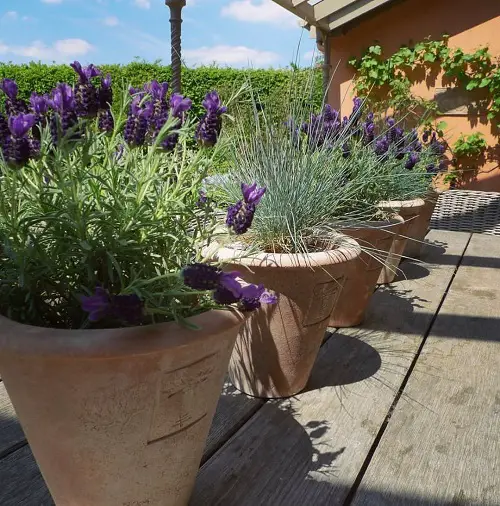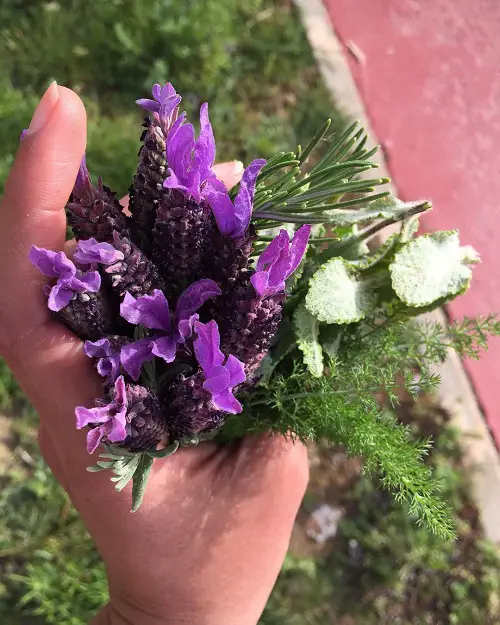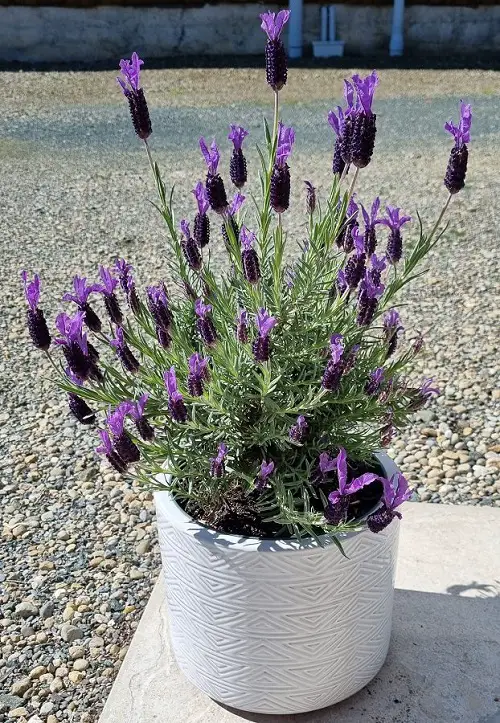The French Lavender comes with a slight ‘toothy’ twist! To know what it is and what makes it different, keep reading!
If you are looking forward to growing a fragrant herb that’s easy to maintain and looks fantastic in container settings, well, the French Lavender is quite a regal choice!
So, What is French Lavender, and How it is Different From a Regular One?
Also popular as the English Lavender, French Lavender has one distinct trait that makes it different from the regular ones out there – it’s serrated or “toothed” leaves. The plant is native to the Mediterranean region, and people also refer it as true lavender. Also, it is more heat tolerant and hardy, too.
This herb has a bushy growth pattern, which makes it an excellent choice for pots—you can keep on those sunny patios and balconies! Not to mention, it also has a long blooming season that goes from early spring to late fall.
Botanical Name: Lavandula dentata
USDA Zones: 8-11
How to Grow French Lavender in Pots?

The best time to grow French Lavender is from spring to summer in most moderate and warm regions. For colder states, you would need to start it indoors in the similar time frame.
When it comes to propagating the herb, cuttings are the best way to do it. Simply find a healthy specimen, and pick a 4-6 inches long stem. Remove the lower leaves, dip the cut end in a rooting hormone, and plant it in a well draining potting mix.
Water well, and ensure it gets bright and indirect light throughout the day. The cutting will root in 8-10 weeks.
Growing it is as same as growing regular lavender and we have a great article on it already, which you must check out!
Right Pot Size for French Lavender
Remember, over time, with right care and maintenance, the plant may grow to resemble a small shrub. Keeping that in mind, starting the plant in a 10-12 inches deep container would be a good idea.
Depending on the growth and spread every 2-3 years, keep on repotting in into a one size bigger container than the old one.
Requirement for Growing French Lavender
Sunlight and Location
If you have a regular lavender or any other herb in your collection, then you already know how much these plants love sunlight, right? Well, the same goes for French Lavender!
You just need to adjust the exposure for these herbs for the best results. Any spot that gets indirect light all through the day is perfect. However, exposing it to 6-7 hours of direct sunlight is a must—for that, an east facing spot is an apt choice.
To preserve the oils in the flowers for best fragrance, avoid exposing the plant to the harsh afternoon sun for longer durations (It can tolerate afternoon exposure more than the regular lavender, but do not exceed it more than 1-2 hours), especially if you live in a warmer climate.
Growing Medium
Though, you can grow French Lavender in any commercially available potting mix, we would recommended you to make your own for the best flowers!
For that, mix 2 parts of garden soil, 2 parts of coir or peat moss, 1 part of perlite or vermiculite, and a handful of dolomitic lime (A small amount of it, 2-3 tablespoons, will help maintain a slightly alkaline environment, something French Lavenders absolutely love!).
You can also go for any pre-mix lavender potting mix available in the market. The plant does best in the pH range of 6.0 and 7.5.
Watering
Understand the fact that with French Lavenders, watering plays a crucial role in the management of essentials oils in leaves and flowers.
Though the plant is very drought tolerant, definitely more than the regular lavender, it is essential that you follow the right play of moisture and dryness to avoid killing the plant and fragrance!
Slightly water-stressing the plant will enhance the concentration of oil in blooms and foliage, making the fragrance more intense! To do so, let the the soil dry out to about an inch at every water change, and let it go dry to about 1.5-2 inches deep from the top, at every third watering. This would do the trick!
Avoid watering the plant daily, or wetting the foliage thinking it will keep it lush and soft—watering daily may kill the plant!
Temperature Range
For the best growth, keep French lavender in the range of 68°F to 100°F (20°C and 38°C). Do not place the herb where the temperature may go below 25°F (-4°C) for a longer durations of time.
French Lavender Care

Do You Need to Fertilize the Plant?
Contrary to popular belief where feeding flowering plants boosts the growth of blooms, the French lavender is relatively low maintenance.
Simply let it be, give it plenty of sunlight, and the plant will keep on producing fragrant flowers! If you may feed the plant too much, it will end up producing lesser blossoms.
However, if you are in mood of boosting the growth, a diluted application of 5-10-10 blend (1/2 of the recommended strength) will certainly help it flower and grow better. Just don’t feed it more than once in 4-6 weeks.
Are there Any Pests and Diseases You Need to Worry About?
Aphids, spider mites and whiteflies are the villains for this fragrant hero! However, if you regularly check up the plant, and provide it with plenty of sunlight, they will be of no issue whatsoever.
In diseases, simply avoid overwatering the growing medium and wetting the leaves. Also, make sure it gets plenty of air circulation (Which will also let the fragrance travel in every part of the house!). This will keep it perfectly safe!
How to Prune French Lavender?
Pruning French lavender is about cutting away dead and damaged parts of the plant from time to time—you can do it anytime you spot them on the plant.
How to Deadhead French Lavender?
Look for the spent flowers on the plant and using a pair of shears, simply snip them out. This will ensure a clean cut without any damage to the stems or leaves. DO NOT CUT green and non flowering stems in the process.
When Does French Lavender Blooms?
The plant usually flowers during late spring to early summer in the United States. In milder climates of the coastal regions, expect it to start flowering around early May.
In colder states, the plant may bloom in June or early July.
Harvesting French Lavender

For culinary purposes, cut the blooms when they are just about to open, typically in late spring or early summer. This will ensure the best scent and taste!
If you want the flowers for display and fragrance, cut them when they are full open, as then oils will be at their peak. Once done, hang the stems upside down in a dry room or a spot that gets no direct sunlight. You will know when they are ready, as the room will be full of their mesmerising fragrance!




